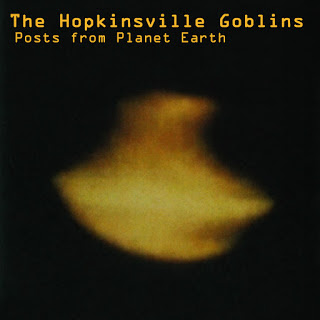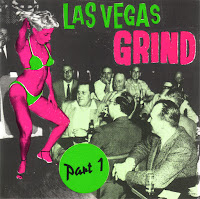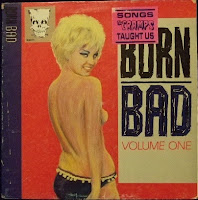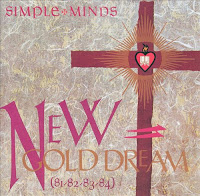I once picked up a book in a library sale about a mysterious
branch of the arts called process music. I didn’t know anything about it but it
looked intriguing and it was only a couple of bucks so what the hell. It turned
out to be one of the most interesting reads I’d had for a long time.
Process music, it turned out, is music that is created with
a physical or experimental set up to create sounds with a minimum of human
input. A primitive example is the Victorian self-playing piano, the pianola,
that used punched paper rolls to activate the keys. People have recently
programmed robots to physically play entire compositions using a similar
principle. The logical modern equivalent of the pianola is techno, using MIDI driven processing to produce sounds with a minimum
of active playing by the, umm, musicians.
Early exponents of process music were more likely to be
scientists than musicians, like Leon Theremin who invented the instrument that
carries his name. Later exponents were the likes of John Cage who physically manipulated
conventional instruments like pianos to produce unusual and dissonant sounds.
Interesting as it sounds, process music can be as dull as dishwater to listen
to (did I mention techno already?). It only becomes interesting when the
process used produces sounds that are so far out your mind can’t work out how
it is done, or so weird they produce a physical reaction like fight or flight
(have you ever seen a dog prick up its ears and sniff the air when it hears a
strange noise – that’s what we are talking about). Music isn’t an intellectual
exercise – it has to reach organs below the neck as well.
Technology opened up all sorts of new doors to process
musicians. Drum machines and delay units, echoplex and tape manipulation.
Throughout the seventies these became the tools of the avant garde. I’m sure
John Cage would have loved to have got his hands on a synthesizer rather than
assaulting pianos with hammers and screwdrivers, (although the synth wouldn’t
have been half as much fun). Manipulating sound is now as easy as a quick
download and plug in to your sound editing software, and a MIDI
keyboard can be made to sound like a brass band. The possibilities are endless
right? Well, yes and no. Using technology for technology’s sake is where the
edge gets rubbed off. Anyone worth their salt following a process to make music
knows that there has to be a human hand behind it, otherwise there is nothing
to feel.
This very long intro brings me to the main subject of this
post: the industrial music of the early 80’s.
Industrial music gets its name from Industrial Records – the
label that was home to Throbbing Gristle in the late 70s – early 80s. Also
included under this banner are groups like Clock DVA, Cabaret Voltaire, 23
Skidoo and (to a lesser extent) the Virgin Prunes, who I’ll get to later.
Throbbing Gristle are the grand daddies of industrial music
(or grand trans-gender omni-sexual beings if you believe Genesis P Orridge
these days). Their music basically defines the genre. Electronic rhythms
splattered liberally with sound effects, warped instruments, snatches of
dialogue and tortured vocals producing an overall effect like an analogue
computer having a nightmare. Powerful stuff. The uninitiated should check out
“20 Jazz Funk Greats” as a starting point. It’s their most accessible work (if
accessible is even a word you can associate with TG) and features a few tracks
you can even quietly get your groove on to. “DOA” also has its moments,
particularly the uber-creepy Hamburger Lady and the almost poppy AB/7A (catchy
title, eh). Serious devotees can try and track down the suitcase full of live
cassettes they released that document just about every gig they did between
about 1976 – 1980. If you dare.
Other industrial acts definitely have their moments, particularly
Cabaret Voltaire who grew from a very noisy art assault collective into one of
the gruntiest of the early house outfits (Prodigy owed their entire existence
in the 90s to these guys). The Cabs largely sit outside process music, so their
relevance here is limited to their first couple of albums and their love of
using snatches of long wave radio dialogue in their compositions. “Mix Up” and
“The Voice of America” are the ones to check out.
I could waste space talking about lesser known acts, but I
want to spend the rest of this post talking about my homeboys the Virgin
Prunes. My homeboys in a spiritual rather than physical sense you understand. I
grew up (a while ago it has to be said) in the South Island of New Zealand. Things
were pretty clear cut back then. You were a part a small population, you
dressed conservatively, acted stoically and liked rugby. Or you didn’t. If you
didn’t you needed to prepare yourself for a life spent on the outside looking
in and being treated with the contempt that came with it. Even surviving that
kind of shit was a challenge, let alone carving out a life for yourself. The
Virgin Prunes came from Ireland,
where you were part of a small population, you dressed conservatively, acted
stoically and stuck to your creed. Notice the similarities?

For a bunch of artistic, questioning, extrovert freaks like
these guys, life was always going to be a bit different. They started life as a
group of outsiders that coalesced into a sort of social club, interestingly
including Bono and The Edge from that other Irish group. This loose gaggle
adopted new names and started a performance group to express themselves (they
also came up with the names of the aforementioned individuals – how many of you
knew Bono was named after a brand of hearing aid?). The Virgin Prunes (which is
Irish slang for a naïve individual) developed several different faces and as
such are an unclassifiable act. They sadly got lumped in with the gothic
movement by lazy UK
music critics based on no more than the fact that they used heaps of hair-gel
and wore make up. But then so did Motley Crue, right. The Virgin Prunes were
way weirder than the pretense any gothic poser could ever put on. Their stage
show was a Dadaist outing complete with props, performance art and
cross-dressing. They put on multi-media exhibitions in art galleries. They
played a close approximation of rock music on occasion and they made some of
the most interesting process music ever recorded.
It’s that process music that I always go back to with them.
Their more conventional music (and some of it was reasonably straight forward
it has to be said) hasn’t aged so well. It still kicks 10 shades of shite out
of almost everything “alternative” these days though so don’t get me wrong. But
their in-the-studio creations are adventurous in the extreme, using everything
from birds to iron bars to make their indefinable sounds. And silence too. They
use silence better than anyone since Philip Glass.

The tracks I’m talking about exist across all their
recordings but are mixed in with the more conventional stuff, so you’ll need to
make a playlist. The studio half of the “Heresie” album has some seriously
ethereal music mixed in with some Irish sing-alongs, noisy primal rock and
other demented ramblings. The original box set came out as two 10 inch records
with a handful of pamphlets containing surrealistic writing and nasty art work.
Good luck finding a copy and no, you can’t buy mine. “A New Form of Beauty” is
where the rubber really hits the road. This originally came out as a set again
containing a 7 inch single, 10 inch EP and a 12 inch LP with a cassette thrown
in for good measure. The whole thing acts as the soundtrack for the art
installation that accompanied its release. I paid an absurd amount for it on
eBay (sans cassette) before it was re-released on CD a few years back. It has a
similar mixture of styles to Heresie, but the overall feel is much more
claustrophobic and intense. It ranges from barely-moving, cracked-ambient,
inner-space explorations like Abbagal, which are vaguely unsettling,
to The Beast, which is as intense as hell and just flat out terrifying. Play
that at maximum volume and watch the curtains start twitching in your
neighbours place. I’ve done it. It’s fun.
But getting back on topic, for their best process music you
have to go to the Over the Rainbow compilation. That ties up a lot of the loose
ends and rarities they did as one-offs on long deleted compilations and
cassettes. The notion of a group is blown away on these pieces and the creative
collective takes over. The CD re-issue excludes the sleeve notes that
accompanied the original LP release, so the descriptions of the processes they
followed is absent. That’s a real shame because without them the tracks loose
some of their wow! factor and they become merely absorbing and interesting
instead. The two key tracks are Mad Bird in the Wood and Third Secret.

Since you won’t have the sleeve notes handy, here is what
they roughly say about these two. Mad Bird in the Wood was recorded in their
ramshackle studio in Dublin
that featured a crumbling roof that allowed pigeons in to roost. Some of the
pigeons would get inside and fly around the rafters looking for an escape
route. The band came up with the idea of recording their fluttering with added
ambient noise. So they slung a collection of microphones over the rafters and
set them swinging so they would feedback off each other. Next they chased the
birds through the swinging mics and rolled the tape. The resulting sounds were
then played backwards and mixed with some additional electronic effects. End
result – one of the most bizarre and ethereal pieces of music ever recorded.
Third Secret is equally spontaneous. When they were
installing the artworks for the New Form of Beauty exhibition they had to set
up a bunch of scaffolding in the gallery to reach the ceiling. One of them came
up with the idea of blind-folding themselves and climbing the scaffolding using
nothing more than iron bars to feel their way up. The clanking of the bars on
the scaffolding was recorded and mixed with some piano chords and whispered
prayers. End result – surrealist sacred music serving as a comment on blind
devotion. Salvador Dali would have loved it.
Like my homeboys, The Hopkinsville Goblins like playing
around with found sounds and processes. They give it to me as a done deal.
There’s plenty of it on Posts from Planet Earth. Their favourite instrument is
the steel watering can on my kitchen window. It’s the first thing you hear on
the album.



















